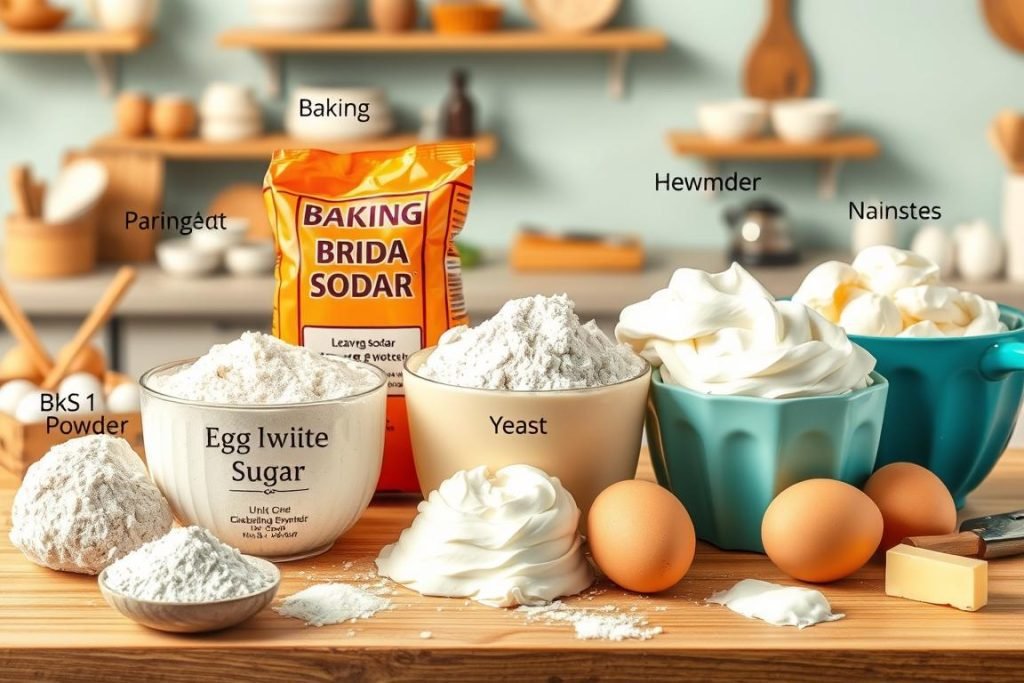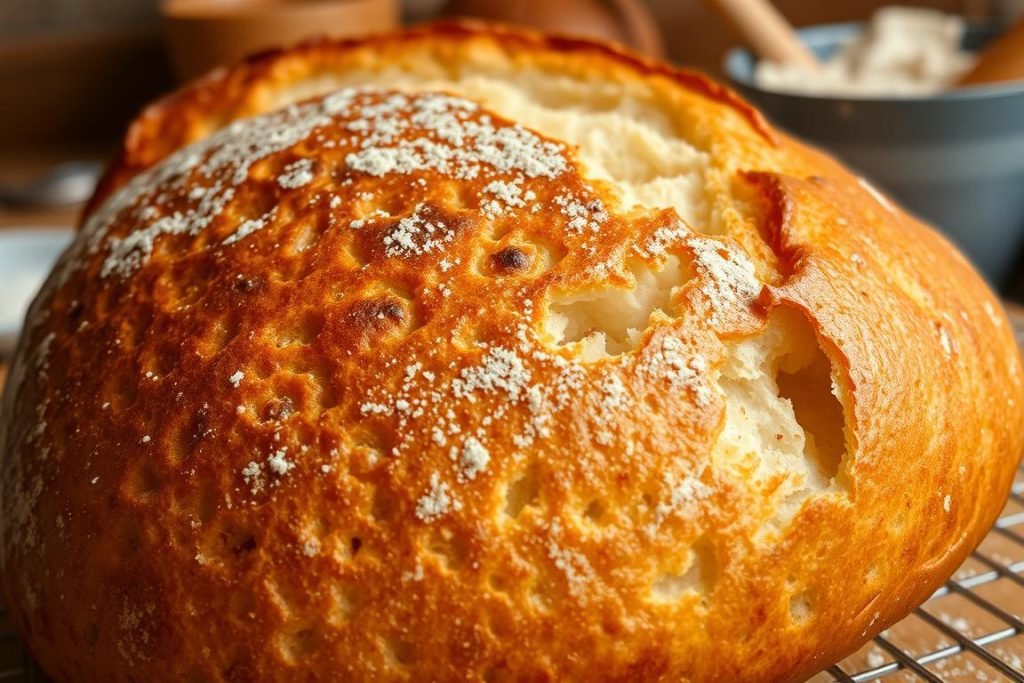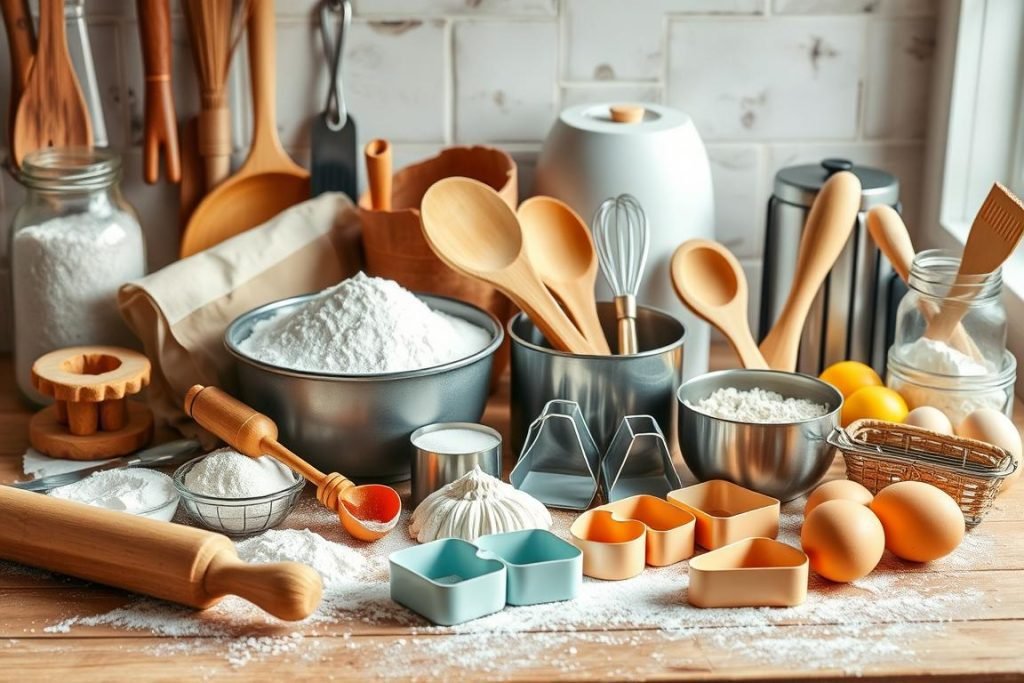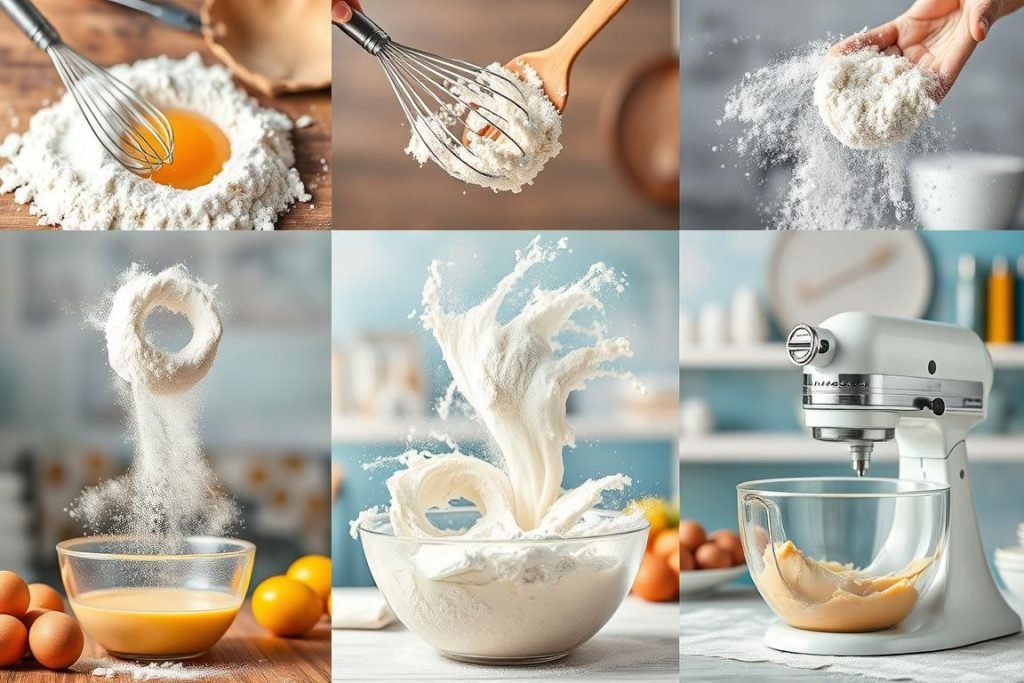Baking Science Explained

Have you ever wondered why bread you bake puffs up perfectly? Or why cookies stay soft for days? It all starts with Baking Science. This is where simple kitchen tries turn into yummy treats. It’s more than just following steps. It’s knowing the culinary chemistry that changes basic ingredients into amazing eats.
When we dive into this tasty science, we find fans like Marky’s Gourmet Foods. They say knowing food chemistry helps you bake goodies that rise well, brown nicely, and feel great to eat. Rahul Mandal, a winner of The Great British Bake Off, thinks of baking as a mix of chemistry, biology, and physics. He says our kitchens are like the world’s oldest labs.
Did you know modern yeasts made baking easier because you don’t have to get them started first? Also, the kind of fat in milk can really change how cakes feel and taste. When we bake, these little facts are very important. They help decide if your baking will be a hit or miss.
Baking needs a bit of science, whether you’re good at it or just starting. So, let’s dress like scientists and discover how baking works. We’ll see how flour, eggs, and sugar can mix in a special way. This brings tasty results.
Key Takeaways
- Learning more about Baking Science helps you understand how ingredients work together and change.
- New yeasts make baking easier by not needing to be prepared ahead of time, which is helpful.
- Knowing how things like baking soda affect your baking can make your skills better.
- Techniques like creaming butter with sugar or making egg whites firm can change your food’s texture and size.
- The content of protein and fat in milk, how sugar keeps moisture, and how to mix ingredients well are key to great baking.
- Understanding exact measurements and the roles of fats, eggs, and sweeteners makes you a real kitchen scientist.
- Books like How Baking Works, Ratio, The Flavor Bible, and BakeWise give you more knowledge to improve your baking.
The Fundamentals of Baking Chemistry
Baking combines art and science. It uses food chemistry to make amazing treats. Knowing the science behind baking boosts your skills. It takes your creations higher. Let’s explore the basics of baking chemistry.
What Happens When You Mix Ingredients?
Mixing ingredients like flour, sugar, and eggs starts chemical reactions. Yeast, in bread-making, turns sugar into gas. This gas makes bread rise and get its texture. The Maillard reaction adds browning and flavor when baking.
The Role of Temperature in Baking
Temperature is key to good baking. It starts reactions like making baking powder release gas. It also sets the structure in baked goods. The right temperature makes these happen well.
Understanding Moisture and Its Importance
The mix of wet and dry ingredients matters a lot. It changes how soft or firm baked treats are. It’s about getting the perfect balance for the desired texture.
The right kitchen gadgets help you bake better. They make measuring and mixing easier. Good tools help in every step of baking.
To show how certain ingredients affect baking, see this table:
| Ingredient | Type | Role in Baking Chemistry |
|---|---|---|
| All-purpose flour | Flour | Provides structure; moderate gluten content balances elasticity and tenderness. |
| Yeast | Leavening agent | Ferments sugars producing CO2 for leavening bread. |
| Baking powder | Leavening agent | Releases carbon dioxide when heated, aiding in the rise of cakes and cookies. |
| Brown sugar | Sugar | Adds moisture and a subtle caramel flavor due to its molasses content. |
| Baking soda | Leavening agent | Requires an acid to activate; contributes to the leavening and browning of goods. |
Knowing about baking chemistry makes you better at baking. Use your knowledge of food chemistry. Create tasty treats that will wow everyone.
Leavening Agents and Their Functions

Understanding different leavening agents can change your baking. They help make baked goods light and airy. Knowing your agents is key whether using bread equipment or pastry tools.
Types of Leavening Agents
There are three types of leavening agents: biological, chemical, and physical. Biological leaveners, like yeast, work well for bread. Chemical leaveners, like baking soda and powder, are quick. They’re great for cakes and quick breads. Physical leavening involves adding air or steam to lift the dough.
How They Affect Texture and Rise
Each agent impacts texture and rise differently. Yeast not only makes dough rise but adds flavor. Baking soda needs acid to react. Baking powder has acid and reacts in different conditions. Techniques like kneading use air or steam to expand inside the dough. Using these agents correctly makes your baking successful.
| Type of Leavening Agent | Common Agents | Typical Use | Impact on Texture |
|---|---|---|---|
| Biological | Yeast (active, instant) | Breads, pizzas | Chewy, airy |
| Chemical | Baking Soda, Baking Powder | Cakes, cookies, quick breads | Light, fluffy |
| Physical | Whipping, steam | Soufflés, choux pastry | Delicate, flaky |
Using the right leavening agent and technique can make a big difference. It affects the taste, texture, and rise of baked goods. This makes baking exciting and rewarding.
The Importance of Gluten in Baking
Gluten is crucial for baking. It is found in wheat, barley, and rye flours. Gluten makes baked goods elastic and textured. Knowing how to use gluten will improve your baking. Let’s explore gluten, its creation, and how it affects baked items.
What Is Gluten and How Is It Formed?
Mixing water with certain flours starts gluten formation. These flours have proteins called glutenin and gliadin. The mix turns stretchy and sticky. This mix is key for the structure of baked goods. Mixing and kneading the dough makes gluten stronger and adjustable. Gluten varies by the flour you use and how much you knead.
| Flour Type | Protein Content | Gluten Potential |
|---|---|---|
| Cake Flour | 10% | Low |
| Bread Flour | 12.7% | High |
| All-purpose Flour | 11.7% | Moderate |
| Whole Wheat Flour | 13.8% | Varied* |
*Whole wheat flour’s gluten structure is affected by bran and germ.
Gluten’s Role in Different Baked Goods
Gluten’s role changes with the baked item you’re making. For chewy bread, you need a lot of gluten. This comes from kneading the dough well. But for soft cakes and pastries, you want less gluten. This means mixing gently. The method you choose depends on what you’re baking.
- Chewy breads: Need lots of gluten. Use bread flour and knead well.
- Tender cakes: Aim for less gluten. Use cake flour and mix lightly.
- Pastry dough: Needs a moderate amount of gluten. It’s in-between bread and cake.
Choose the right flour and technique for what you’re baking. Baking tools are important for this. They help you mix or knead correctly. Look for visual signs and use experience to get the perfect texture and rise. Baking is both creative and precise.

The Maillard Reaction: Flavor Development
Baking shows us unique chemical reactions. One key reaction is the Maillard reaction. It’s not just about making food brown. It makes smells and tastes that make your mouth water. When baking, this reaction happens as things heat up.
What Is the Maillard Reaction?
The Maillard reaction happens with heat. It’s when proteins and sugars in food change. This change makes new tastes and colors. Every ingredient affects this reaction in its way.
How It Enhances Flavor and Color
Turning your kitchen into a lab is interesting. Different conditions change the Maillard reaction a lot. The type of amino acids and sugars, the temperature, and pH levels matter. Getting these right changes how your baking turns out.
Here’s what impacts the Maillard reaction:
| Condition | Effect on Maillard Reaction |
|---|---|
| Protein and Sugar Types | Specific combinations result in unique flavors and colors. |
| Temperature Above 300°F (149°C) | Ideal for initiating the reaction, commonly observed in searing meats or baking crusts. |
| Adjusting pH level | Modifying with baking soda or acid can enhance or suppress the reaction, adding control over flavor profiles. |
| High Cooking Temperature | Accelerates the reaction, leading to rapid flavor and color development. |
| Surface Dryness | Removing moisture helps in achieving a more efficient and desirable Maillard reaction. |
| Extended Cooking Time at Lower Temperatures | Leads to deeper flavor infusion from the Maillard reaction, desirable in slow-baked dishes. |

Understanding the Maillard reaction helps in baking. It lifts both the taste and look of your baking. Both new and skilled bakers can do amazing things with it. Use the right tools and quality ingredients. This way, you’ll make wonderful foods to enjoy.
The Role of Fats and Oils in Baking
Fats and oils are key in making baked goods. They help get the right texture and flavor. It’s both science and art.
Different Types of Fats Used
Knowing about different fats can make baking better. Butter, with about 80% milkfat, adds creamy taste and helps with rising. For vegans, plant-based shortening is a good pick. It’s healthy for your kitchen, too.
Margarine and oils also are options. Margarine works as a fat source. Oils make things tender, great for moist brownies or breads.
The Impact of Fats on Texture and Flavor
The fat you choose changes how baked goods feel and taste. Butter adds richness, important for pastries. Neutral oils let other flavors shine, perfect for decorated cakes.
The structure of baked items relies on fat. Solid fats like butter make cakes light and airy. Oils keep things moist longer, making them stay fresh.

Trying different fats can change your baking results. It affects consistency, taste, and how it all works together. Knowing about fats and oils can improve your baking skills a lot.
Sweeteners and Their Baking Properties
Sweeteners are key for bakers. They add sweetness and affect texture, structure, and how long baked goods last. Whether it’s simple sugar or complex molasses, your choice changes everything. This includes taste and how long it can be stored.
Natural vs. Refined Sweeteners
Choosing between natural and refined sweeteners depends on what you’re baking. Natural sweeteners come from fruits and trees. They add special flavors and health benefits. Refined sweeteners are made through processes like sugar refining. They provide strong sweetness needed for certain recipes.
How Sweeteners Affect Taste and Texture
Sweeteners do a lot besides adding sweetness. They help in caramelizing, giving baked goods a rich color and unique taste. They also help bread rise by feeding yeast. Knowing this lets you control the outcome.
For instance, sugar stops gluten from forming too much. This keeps cakes and cookies soft. It also reacts with amino acids to create a golden color and great smell.
When picking sweeteners, think about how they ferment, their moisture, and sweetness. This knowledge helps you choose right for any baking. Whether you’re a professional or baking at home, it’s important to know.
| Sweetener Type | Common Sources | Properties | Uses in Baking |
|---|---|---|---|
| Sucrose | Sugar cane, Sugar beets | Tenderizing, Sweetening | Cakes, Cookies |
| Molasses | Sugar beet refining byproduct | Moisture retention, Rich flavor | Dark breads, Gingerbread |
| Honey | Bee nectar from flowers | Humectant, Natural preservative | Health bars, Soft breads |
| Maple Sugar | Maple tree sap | Flavoring, Mild sweetness | Pancakes, Pastries |
| High Fructose Corn Syrup | Corn starch | Sweetening, Cost-effective | Commercial baking, Snacks |
Remember, the right sweetener makes your baking tastier. It also improves how your baked goods look and last. So, choosing wisely is key.

The Science of Egg in Baking
Eggs are very important in baking. They do more than just add to the mix. They help give baked goods the right texture, taste, and look. Understanding eggs and using the right tools can make your baking better.
Functions of Eggs in Recipes
Eggs help your baked goods hold together and stand up. They turn solid and bind things together. Beating egg whites makes dishes light and fluffy. This is key for things like soufflés. The right utensils can make egg whites puff up a lot, which is great for these dishes. Eggs also make dressings and sauces smooth. This is because of something in the yolks called lecithin.
How to Choose and Use Eggs Effectively
Choosing and using eggs the right way can change your baking. Fresh eggs are best for structure. They sink in water and have a tiny air pocket. Room temperature eggs make better foams, especially the whites. This is very important for some recipes. Tools like fine brushes can put egg wash on baked goods. This makes them shiny and colored.

| Aspect | Function | Optimal Temperature (°F) |
|---|---|---|
| Egg White Coagulation | Binds ingredients, adds moisture | 140 – 149 |
| Egg Yolk Setting | Thickens mixtures, adds richness | 144 – 158 |
| Whole Egg Coagulation | Adds structure, emulsifies | 156 |
Knowing how to use eggs right in recipes is key. The right kitchen tools help a lot. This makes sure your baking is as pretty as it is tasty. Using eggs isn’t just science. It’s also an art that adds to flavor, texture, and look. Eggs are very important in cooking.
Baking Techniques and Their Scientific Rationale
When you start baking, knowing the science behind it helps a lot. The tools you choose and the way you mix matter a lot for tasty, well-made baked goods.
The Importance of Mixing Methods
Mixing does more than just put ingredients together. It starts reactions that make your treats taste and feel right. Using the right bowls and mixers helps. This lets you do the “creaming” method right. Here, you mix sugar and butter to add air. This makes cakes and cookies fluffy.
This method is key for getting the right fluffiness and smoothness. It spreads fat evenly in the dough or batter.
How Folding and Kneading Affect Your Dough
Folding is gentle, unlike vigorous mixing. It’s key for things like mousse or sponge cakes. Folding right keeps the mix light. Kneading is crucial for breads and pizza dough. It helps gluten form a strong network. This is important for the dough’s stretch and the bread’s texture.

Choosing the right tools, like big strong mixing bowls, is important. A good bowl gives you room to mix without making a mess.
Understanding each method’s role is key to baking well. It matters whether you are whipping batter, activating yeast, or mixing dry and wet ingredients. Each method has a special goal. This helps your baking projects succeed.
To sum up, baking mixes science with skill. By getting the mixing, folding, and kneading right, you can improve your baked goods. Good tools and methods take your baking from okay to amazing!
Troubleshooting Common Baking Issues
Sometimes your baking doesn’t turn out how you wanted. It’s important to figure out why. This could be due to not paying enough attention while baking. Knowing what went wrong helps make your baking better, whether you’re a pro or just starting.
Identifying Problems in Your Baked Goods
Using your baking tools the wrong way can mess up your baking. An oven not heating right can ruin your cakes and cookies. You should check if your oven heats evenly. Also, check things like yeast before using them to make sure they’re not out of date. Using exact measurements is very important for perfect baking results.
Tips for Achieving Perfect Results Every Time
Good baking tools help avoid common issues. Don’t open the oven too often; it can mess up your baking. Make sure your ingredients are at room temperature before starting. Understanding baking science is key to great results. Use good ingredients and follow baking tips closely for the best bakes.